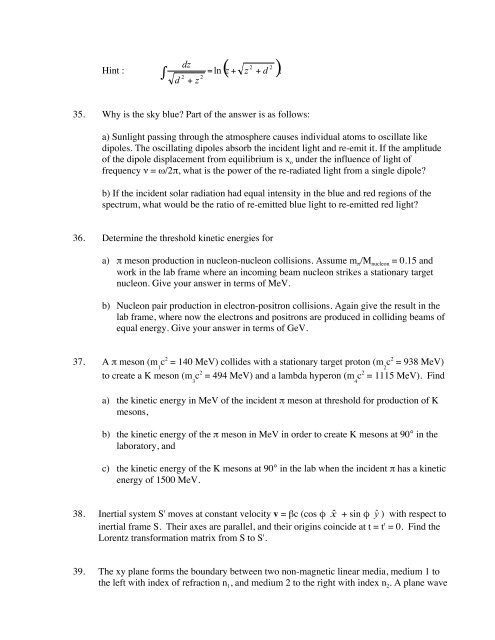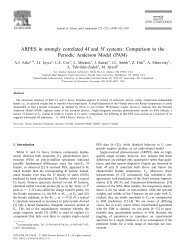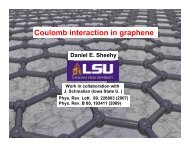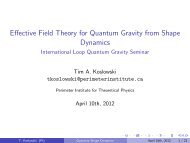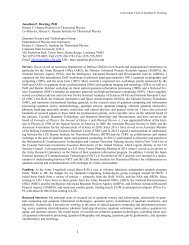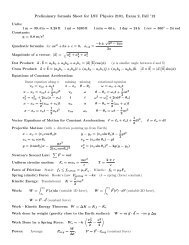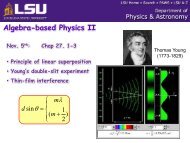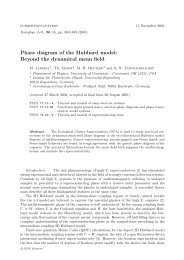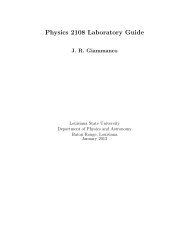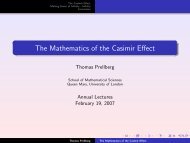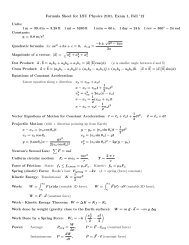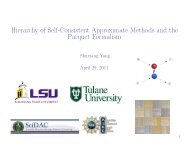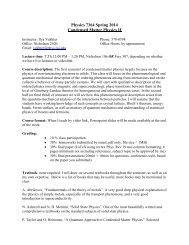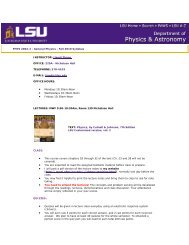Electricity and Magnetism - Department of Physics & Astronomy
Electricity and Magnetism - Department of Physics & Astronomy
Electricity and Magnetism - Department of Physics & Astronomy
You also want an ePaper? Increase the reach of your titles
YUMPU automatically turns print PDFs into web optimized ePapers that Google loves.
dz2 2Hint : ∫ = ln( z + z + d ).2 2d + z35. Why is the sky blue? Part <strong>of</strong> the answer is as follows:a) Sunlight passing through the atmosphere causes individual atoms to oscillate likedipoles. The oscillating dipoles absorb the incident light <strong>and</strong> re-emit it. If the amplitude<strong>of</strong> the dipole displacement from equilibrium is x o under the influence <strong>of</strong> light <strong>of</strong>frequency ν = ω/2π, what is the power <strong>of</strong> the re-radiated light from a single dipole?b) If the incident solar radiation had equal intensity in the blue <strong>and</strong> red regions <strong>of</strong> thespectrum, what would be the ratio <strong>of</strong> re-emitted blue light to re-emitted red light?36. Determine the threshold kinetic energies fora) π meson production in nucleon-nucleon collisions. Assume m π /M nucleon = 0.15 <strong>and</strong>work in the lab frame where an incoming beam nucleon strikes a stationary targetnucleon. Give your answer in terms <strong>of</strong> MeV.b) Nucleon pair production in electron-positron collisions. Again give the result in thelab frame, where now the electrons <strong>and</strong> positrons are produced in colliding beams <strong>of</strong>equal energy. Give your answer in terms <strong>of</strong> GeV.37. A π meson (m 1c 2 = 140 MeV) collides with a stationary target proton (m 2c 2 = 938 MeV)to create a K meson (m 3c 2 = 494 MeV) <strong>and</strong> a lambda hyperon (m 4c 2 = 1115 MeV). Finda) the kinetic energy in MeV <strong>of</strong> the incident π meson at threshold for production <strong>of</strong> Kmesons,b) the kinetic energy <strong>of</strong> the π meson in MeV in order to create K mesons at 90° in thelaboratory, <strong>and</strong>c) the kinetic energy <strong>of</strong> the K mesons at 90° in the lab when the incident π has a kineticenergy <strong>of</strong> 1500 MeV.38. Inertial system S' moves at constant velocity v = βc (cos φ xˆ + sin φ ŷ ) with respect toinertial frame S. Their axes are parallel, <strong>and</strong> their origins coincide at t = t' = 0. Find theLorentz transformation matrix from S to S'.39. The xy plane forms the boundary between two non-magnetic linear media, medium 1 tothe left with index <strong>of</strong> refraction n 1 , <strong>and</strong> medium 2 to the right with index n 2 . A plane wave


